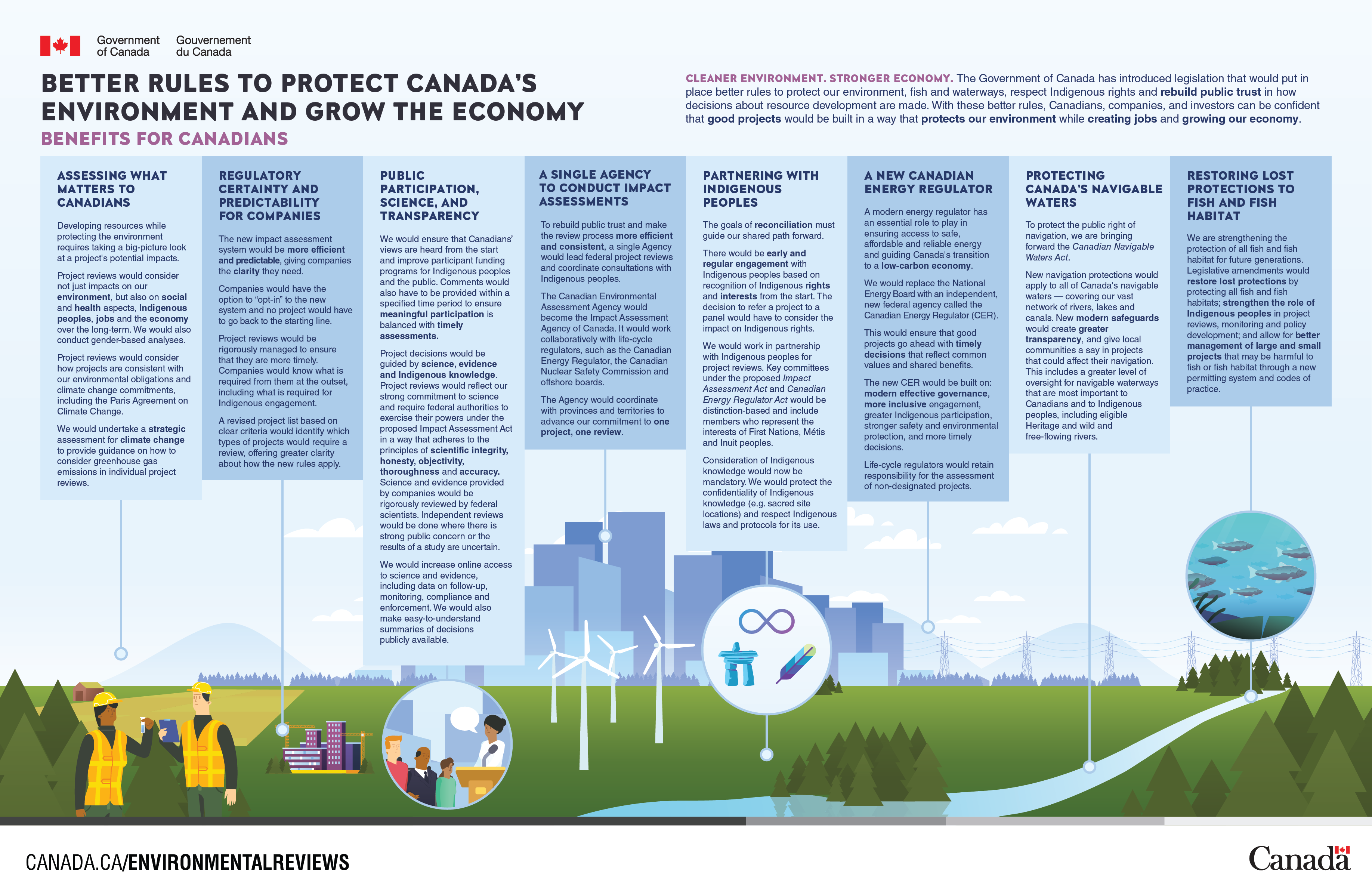Canadians
Archived content
On August 28, 2019, the Impact Assessment Act, the Canadian Energy Regulator Act, and the Navigation Protection Act came into force. This archived Web page remains online for reference, research or recordkeeping purposes. This page will not be altered or updated.

Developing resources while protecting the environment requires taking a big-picture look at a project's potential impacts. Reviews would consider not just impacts on our environment, but also on social and health aspects, Indigenous peoples, jobs and the economy over the long-term. We would also conduct gender-based analyses and ensure that Canadians’ views are heard from the start.
How would these changes affect you?
- A single Agency, the Impact Assessment Agency of Canada, to lead all impact assessments for major projects
- A new Canadian Energy regulator
- Canadians’ views to be heard from the start, and improved participant funding programs
- Increased online access to science and evidence
- Easy-to-understand summaries of decisions to be made publicly available
- Gender-based plus analyses to better understand impacts on communities
- New navigation protections to apply to all of Canada's navigable waters
- Strengthening the protection of all fish and fish habitat for future generations
Long description
Cleaner environment. Stronger economy. The Government of Canada has introduced legislation that would put in place better rules to protect our environment, fish and waterways, respect Indigenous rights and rebuild public trust in how decisions about resource development are made. With these better rules, Canadians, companies, and investors can be confident that good projects will be built in a way that protects our environment while creating jobs and growing our economy.
Assessing what matters to Canadians
Developing resources while protecting the environment requires taking a big-picture look at a project's potential impacts.
Project reviews would consider not just impacts on our environment, but also on social and health aspects, Indigenous peoples, jobs and the economy over the long-term. We will also conduct gender-based analyses.
Project reviews would consider how projects are consistent with our environmental obligations and climate change commitments, including the Paris Agreement on Climate Change.
We would undertake a strategic assessment for climate change to provide guidance on how to consider greenhouse gas emissions in individual project reviews.
Regulatory certainty and predictability for companies
The new impact assessment system would be more efficient and predictable, giving companies the clarity they need.
Companies would have the option to “opt-in” to the new system and no project would have to go back to the starting line.
Project reviews would be rigorously managed to ensure that they are more timely. Companies will know what is required from them at the outset, including what is required for Indigenous engagement.
A revised project list based on clear criteria would identify which types of projects would require a review, offering greater clarity about how the new rules apply.
Public participation, science, and transparency
We would ensure that Canadians’ views are heard from the start and improve participant funding programs for Indigenous peoples and the public. Comments would also have to be provided within a specified time period to ensure meaningful participation is balanced with timely assessments.
Project decisions would be guided by science, evidence and Indigenous knowledge. Project reviews would reflect our strong commitment to science and require federal authorities to exercise their powers under the proposed Impact Assessment Act in a way that adheres to the principles of scientific integrity, honesty, objectivity, thoroughness and accuracy. Science and evidence provided by companies would be rigorously reviewed by federal scientists. Independent reviews would be done where there is strong public concern or the results of a study are uncertain.
We would increase online access to science and evidence, including data on follow-up, monitoring, compliance and enforcement. We would also make easy-to-understand summaries of decisions publicly available.
A single Agency to conduct impact assessments
To rebuild public trust and make the review process more efficient and consistent, a single Agency would lead federal project reviews and coordinate consultations with Indigenous peoples.
The Canadian Environmental Assessment Agency would become the Impact Assessment Agency of Canada. It would work collaboratively with life-cycle regulators, such as the Canadian Energy Regulator, the Canadian Nuclear Safety Commission and offshore boards.
The Agency would coordinate with provinces and territories to advance our commitment to one project, one review.
A new Canadian Energy Regulator
A modern energy regulator has an essential role to play in ensuring access to safe, affordable and reliable energy and guiding Canada's transition to a low-carbon economy.
We would replace the National Energy Board with an independent, new federal agency called the Canadian Energy Regulator (CER).
This would ensure that good projects go ahead with timely decisions that reflect common values and shared benefits.
The new CER would be built on: modern effective governance, more inclusive engagement, greater Indigenous participation, stronger safety and environmental protection, and more timely decisions.
Life-cycle regulators would retain responsibility for the assessment of non-designated projects.
Partnering with Indigenous peoples
The goals of reconciliation must guide our shared path forward and the United Nations Declaration on the Rights of Indigenous Peoples would be clearly reflected in key provisions of the proposed legislation.
There would be early and regular engagement with Indigenous peoples based on recognition of Indigenous rights and interests from the start. The decision to refer a project to a panel would have to consider the impact on Indigenous rights.
We would work in partnership with Indigenous peoples for project reviews. Key committees under the proposed Impact Assessment Act and Canadian Energy Regulator Act would be distinction-based and include members who represent the interests of First Nations, Métis and Inuit peoples.
Consideration of Indigenous knowledge would now be mandatory. We would protect the confidentiality of Indigenous knowledge (e.g. sacred site locations) and respect Indigenous laws and protocols for its use.
Protecting Canada’s navigable waters
To protect the public right of navigation, we are bringing forward the Canadian Navigable Waters Act.
New navigation protections would apply to all of Canada's navigable waters — covering our vast network of rivers, lakes and canals. New modern safeguards would create greater transparency, and give local communities a say in projects that could affect their navigation. This includes a greater level of oversight for navigable waterways that are most important to Canadians and to Indigenous peoples, including eligible Heritage and wild and free-flowing rivers.
Restoring lost protections to fish and fish habitat
We are strengthening the protection of all fish and fish habitat for future generations. Legislative amendments would restore lost protections by protecting all fish and fish habitats; strengthen the role of Indigenous peoples in project reviews, monitoring and policy development; and allow for better management of large and small projects that may be harmful to fish or fish habitat through a new permitting system and codes of practice.
